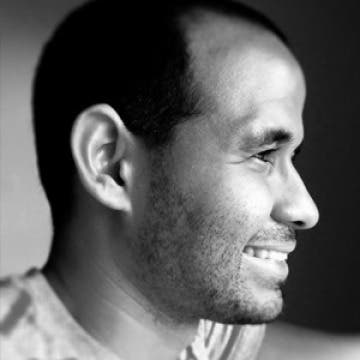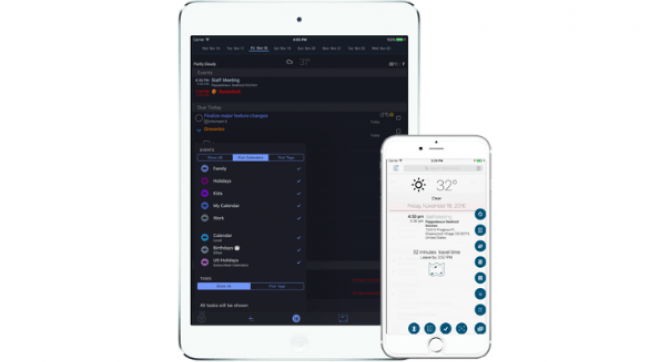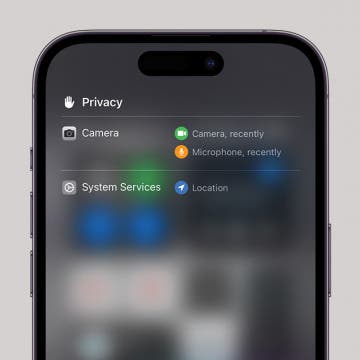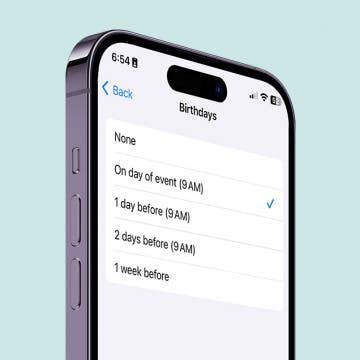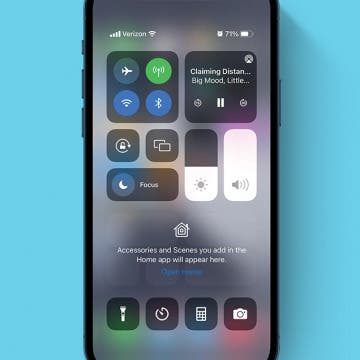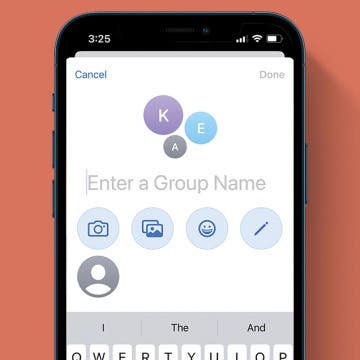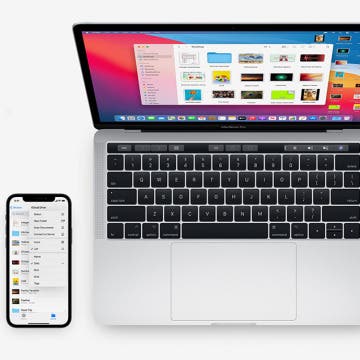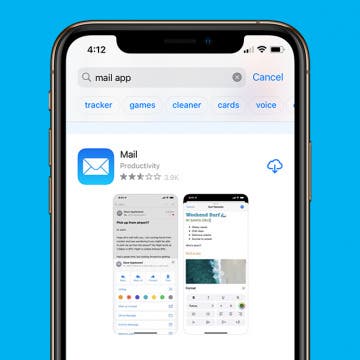
There's really no limit to what you can do with your iPhone. In this interview, I get the opportunity to talk to Kristian Day, a filmmaker from Iowa who managed to shoot an entire TV show with his iPhone, and sell it to a local network. He talks about how he got started, the best apps for filming, and overcoming rejection. Check it out below!

Interview Transcript
(Transcription done by Speechpad.com)
Alex: Hi there everybody. This is Alex Cequea. I'm the editor in chief of
iPhone Life and Android Life magazine. This is our mobile
interview series where we interview the movers and shakers in
the mobile space. Our guest today is Kristian Day. He's a film
maker, entrepreneur, and exotic composer from Iowa. He has the
unique distinction of creating and shooting an entire TV show on
his iPhone and we're going to talk to him about it today. Thank
you so much for being here, Kristian.
Kristian: Thank you for having me, Alex.
Alex: So first of all, tell me about the show. Tell me about the show that
you made. What is it about?
Kristian: Okay. Well back in 2012, I was up late at night working and a
guy who's famous in the Des Moines restaurant scene, Sam Allen,
posted online, he said, "I really need a cooking show." Now Sam
is not your average looking chef. He was this big bearded guy,
tattoos, listened to Black Metal, and he had a restaurant that
was a mobile restaurant called Taco Apocalypse. It was mobile at
the time. And I thought, this could be something really fun to
do. To have a TV show that was punk rock. But originally when we
met, I what I wanted to do and I said, "This can be man's
cooking show." When I say man's, it's not steaks or anything; I
wanted to do something sort of highbrow with what we were
cooking, but we were doing it in a very lowbrow fashion. And
originally, we weren't going to shoot on the iPhone, we were
going to use some JVCs. I thought that this could be something
that could be marketed very well. It was simple, it wasn't
complicated. And I could sell it easily by saying [inaudible
01:52] the Punk Rock cooking show. That's all you need to say
and you get the idea of what we're doing. We pitched the idea to
a local station - channel 17 here in Des Moines. And they were
interested in it. And they said, "Well let's do a pilot on
Christmas Day." Do a holiday special that would lead into a
series. We made the arrangement and it's interesting going back
to that time it was just a whacky idea. I used to do things
because I feel that, Oh, this is something really interesting.
But now it's changed. What happened was what lead to the iPhone
thing is I had some gear stolen - my main cameras.
Alex: I was going to ask you about that.
Kristian: Yeah. The gear was stolen, literally, two weeks before we shot
the pilot.
Alex: Oh, my God.
Kristian: Well, what do you do? I didn't have the funds to go buy
[inaudible [03:03]. These were $6,000 cameras that were stolen.
Now granted, they were outdated at this point but they had nice
lenses. And I'm just like, what am I going to do. Even my
digital recorder - my portable recorder was stolen. And I said,
"I can maybe buy a new recorder, but I've got nothing." And I
had this arrangement set up already, this deal for this TV show;
I've got to make it. Towards the end of September, I went
camping and I was thinking, the iPhone can do all this stuff.
What about maybe making the show on the iPhone. Can it do that?.
You see these ads that say, "You can shoot full 1080 HD video."
But when you actually look at it, it looks like garbage. It
still looked bad. I said, "I don't know if I can do it." So I
did some research. And this is just how time and technology
changes. An app came out just a few weeks before this happened
and it was called, Film Maker Pro. I didn't quite trust it so I
looked online. I looked at some YouTube test videos. I was like,
My God. This is gorgeous. And I remember when I had told Sam,
"Hey" I slide it in there I was like, "Hey. Listen man. We're
also going to shoot this on the iPhone." And this first thing,
he was like, "What?"
Alex: Just slip in there.
Kristian: Yeah, just slip that in there. And he's like, "Is this going to
jeopardize quality?" I'm like, "No, it'll be great." I really
didn't know what it was going to be. It was a hit and miss, but
you'll fast forward to now, that's the whole aesthetic. We have
the opportunity to shoot with other things, but I'm like, No. We
got to shoot it on the iPhone. This is in fact, not a 5 or the
5S which has amazing video quality, this was on a 4S.
Alex: That's incredible.
Kristian: It just happened.
Alex: So tell me. You use Film Maker Pro. What other apps did you use?
Kristian: Besides Film Maker Pro, I play around with some of the audio
recording programs. Actually, the voice memo on here, actually,
does pretty good audio. Now we were trying to capture audio
directly, because Film Make Pro does allow you to capture
uncompressed audio. However, it's really difficult to do that
and shoot. So we did have to do that separately. I do use a
light meter app which I believe is called Light Meter. And that
helps but we don't really use lights, but I can take
measurements with it to figure out, Okay, this will work and
this way I'll have enough light to do it. I also use the Eight
Millimeter app that was made famous because of Searching for
Sugar Man. That is a great app. Now, it doesn't shoot 10A, it
shoots 720, but I've seen the blow up on it on the big screen
and it looks great. The quality with it is fantastic. And the
fact that you can take things out; you can do all these
different effects to make it look like an old movie camera. It
doesn't look corny. Remember the iMovie days where could and the
Eight Millimeter effect and it would play the loop of the
stripes and stuff?
Alex: Right.
Kristian: This actually has some texture and you can take texture out. So
you can do some really cool stuff with it. But aside from that,
I did play with Amos DSLR which is another decent, quality video
app you can get for you iPhone. However, it couldn't do what
Film Make Pro does. Film Make Pro has one big asset; It can
encode at 50 megabytes per second. The bit rate's really high.
DSLR, which is what a lot independent filmmakers and web video
guy's use, only maxes out at 38 megabytes per second, okay?
Alex: Wow. That's amazing.
Kristian: Yeah. And Blue Rays are encoded at 40 megabytes per second. So
the iPhone 4S could encode at 50.
Alex: That's incredible.
Kristian: Right. Now what that does is if I shoot that video, convert it
to the Apple Pro Res, which is the file format that I edit in, I
can bring it into Final Cut and edit and actually do effects to
it - do color correction. If you start doing color correction on
a low bit rate video such as DSLR, you notice it breaks up very
quickly. You start to see the pixels. But with the iPhone, it
still looks really smooth. The limitations, though, are there.
You have this built in lens that you can't change. You can add
filters and stuff to it. I use olloclip which is actually a
sponsor of us. They throw us the new olloclips every time one
comes out. They're great.
Alex: Yeah. We know those guys well. We advertise with us too and I've
tried out all their stuff. I actually have one over here it's
one of the latest ones from CES. It's the Macro 3-n-1.
Kristian: We don't have that one yet. That looks great.
Alex: I got in Vegas at CES. They were unavailing it.
Kristian: Nice. They do some great quality stuff.
Alex: Totally.
Kristian: The other thing I use, Zacuto, they are sponsored. They gave us
the point-and-shoot which I can basically put in which the
iPhone goes into a holster and it has a pistol grip. And I
attached that to a mono pod so I can get some better balance and
do some handheld stuff. In fact, the show, about 90 percent of
it, I had a mono pod attached to it to help with balancing.
Because it is difficult to do a hand held with ... And I'm doing
pretty good with hand held right now. But when you're moving
around trying to get it, it's really hard, because you're right
on it. Another great piece is the EM CAD, the Owl [inaudible
09:16] which is a device that a wide angle converter, but you
can also attach a 35 millimeter adapter. So I can actually use
DSLR lenses with my iPhone which is a hit and miss. Because they
have to put in a little sensor in there that's noisy, but you
can do some cool stuff with it with focusing and things when you
get some [inaudible 09:40]. That's more for art sake. Alo Clip
is fantastic. We use the Alo Clip all over the show.
Alex: Very cool. That's great, man. That's awesome. And just for the people
who are watching now, you mentioned you're doing a pretty good
job doing hand held right now. We're doing this on his iPhone.
He's shooting on his iPhone. So we were joking that he doesn't
use anything else.
Kristian: Yeah, I like how you said, He's doing great hand held, then I
was switching hands and it tilted a little bit. I sometimes
sound like a technology buff folks, but when it comes to certain
things like Skype, my mind just looks and it's says, "I don't
know how to use this." Technology changes overnight. If loosing
that equipment did not happen when it did, if it could have
happened earlier, we may not have had a show. But it changes so
fast.
Alex: I know. That's crazy. So tell me a little bit about that. So you did
the special and then what happened after that for you to sell it
them and do your series?
Kristian: Well after we did it, we actually didn't go with that first
network. Here's what makes it really difficult to do what we do.
Unless the station itself produces it in-house, no one really
knows how, at least in this area, how to shoot and encode and
close caption to deliver original content. It's very difficult.
And there are two things that make it really difficult. One, is
the format. To deliver the final product is MXF which is a wrap
and you also have it closed caption. Now, closed caption seems
like something not a big deal, because most people don't look at
anything that's closed captioned or has the captions on it. But
at the time, only one piece of software did it and it was three
to four thousand dollars. But you could hire everybody to do it
for you for a hefty amount. So we had a lot of technology
barriers. The show did air, but when it aired, no one could
figure out the format. And I don't blame the station, because
the chief engineers do not deal with what we're dealing with on
a regular basis. They get a tape of an HD Cam tape of the final
shows of what airs and they just pop it in, it downloads, it's
done, and they don't do anything. When it comes to having to
bring a file format in and do all this stuff, they don't know.
And I got frustrated and I said, "You know what? I don't know if
this is worth it right now." So I took it away and I sat on it
for a little bit. But I don't want to let it go, because we got
Nielsen ratings and for Christmas Day at 8:00 a.m., we had over
800 viewers just in the Des Moines market. Which doesn't seem
like much but that's how many people did tune in. So I set up
for a little while and I had a friend over at the KCCI, the
Hersh station here, and she's head of sales. And I just said,
"Hey. We have this pilot Sam, Sam had gotten bigger since then
because he's this micro celebrity in this area and people just
follow him, whatever he does and wherever he goes. So I showed
her the pilot and they said, "Hey, we really like this. We may
be able to do something." At that time, they had the Me TV
channel. Do you guys get that in Fairfield, Me TV?
Alex: I don't think so. I'm not sure actually.
Kristian: It's one of those digital sub channels, 8.2 is what it is here
in town. And they said, "Well we're starting to do some custom
programming on there." At the time, the Vikings were going to do
a pregame show. And they said, "This would be great to have your
show and then the Vikings pregame show." And I said, "OK." I
told Sam, "All right. We got it. Let's start shooting." Well,
that got pushed back all the way in May. And they said, "We're
going to start in June." I said, "All right." And it got pushed
back all the way to October. Well, in the midst of all that, we
shot a bunch of shows, tried to get ahead. Sam opened a
restaurant here in town, actually opened a brick and mortar
location. So he was getting a lot of attention. And then the
Vikings pulled out. And so I said, "Well the Vikings pulled
out." To me, that was our anchor. That was like, okay, that's
going to help drive people to watch us. Well, they pulled out.
And I got a little nervous and it came down to when they said,
"Well, you could produce a whole hour of the show." And I said,
"I can't do that. I don't think people would remain interested."
They said, "Well you could do two half hour shows." So I sold
them [inaudible 15:20] in the pan. But I also sold them .... I
literally made up a secondary show in 20 minutes and had it
start shooting two weeks before we first aired.
Alex: Wow. That's crazy.
Kristian: Yeah. And that was intense.
Alex. So a whole new show.
Kristian: A whole new show. It was called Fork in the Road with Sherry
Clark which was a raw food vegan more holistic show. It probably
would do very well in Fairfield. I produce that and got both
shows in the can. And the next was getting the formats down
again, because this is a different station, different server. We
went back and forth. I found a company that would do the closed
captioning and that at a hefty amount times two shows. So a lot
of our initial sponsorship dollars that we were getting was
going towards that. And this just shows how technology changes.
Come mid October, Adobe released Adobe Premier CC 7.1, the
update. That's been the first affordable program that you'd be
able to code the MXF. And it was really surreal because no one
knew. I was [inaudible 16:42] online still. There's got to be a
better way to do this. And [inaudible 16:50] coding for you and
you're good to go. And I'm like, "That's insane. You cannot tell
me that that's the only way to do it." But again, just like when
I lost my equipment and had to start shooting the iPhone and
literally weeks before that app had come out, this just
happened. So we were able to shoot the show and we got a good
pattern down. We would shoot [inaudible 17:13] on Mondays, okay?
And then on Tuesdays, we would edit. Wednesday we would close
caption, final encoding, I would deliver a hard drive on
Thursday and as you , I run the movie theater in Fairfield, I
would come to Fairfield, then I would actually watch the show
from my iPad in the lobby, because it would air on Sunday
mornings. Come back to Des Moines and start over again. I would
have Sunday night off.
Alex: And you could sleep on Sunday.
Kristian: Yeah. That's why I said earlier, "It's still here. It's still
going." And I'm actually at that the point now where I'm ready
to upgrade to a 5S. Part of the limitations too is your hard
drive on your phone. Now, I only have a 32 gig phone and
shooting at the high bit rate equals to about 1,000 gig a
minute, minute and a half. So you had to be very...
Alex: Wow. Yeah. So you got about 30 minutes or so max.
Kristian: You get about 30 minutes I would try to have a hard drive there
to download stuff. Plus, it drains your battery big time when
you shoot. But then Sam had a five so, if my phone was dead, I
would put my phone down, grab his phone, and then start shooting
again. So really, you have unlimited amount of cameras because
everyone has...
Alex: You just pass around a hat.
Kristian: Yeah.
Alex: Please put your phones, we need more cameras today.
Kristian: Exactly.
Alex: Oh, that's so funny.
Kristian: I was really cool. [inaudible 18:55]
Alex: Oh, you froze there for a minute.
Kristian: All right. How am I now?
Alex: Okay, you're good. So let me ask you about the reception of it.
Because when you pitch it to these channels, it's a cool
content, it's a good idea, how receptive were they to the fact
that you were shooting it on an iPhone?
Kristian: They laughed at me.
Alex:
Kristian: I'll tell you, honestly, the average audience member didn't
care.
Alex: Right. Probably a lot of people, I'm sure, couldn't really tell even.
Kristian: No. The people that had a problem, and I get a lot of remarks
about it, was the industry scene of Des Moines. We have two
major commercial production houses here - screen scapes and
applied art and technology that spend lots of money. We have
guys with some big toys to make these things and there was a
part of me, the stubborn, arrogant, punk kid that's still
somewhere up here, thought ... A lot of these guys here would
spend money and get companies to 15, 20,000 dollars to shoot a
pilot hoping someone would pick it up, but no one ever would.
And they would spend all this money burning the scene to try to
get people to put up money for pilots. And I said, "You know
what? We shot this with literally nothing, an iPhone." And a lot
of those guys were very much talking about, "He makes stuff on
his iPhone." And someone even went as far as shooting a video on
their regular iPhone video app on their $25,000 Red camera and
then go, "Oh, look at me, I'm shooting on a HD iPhone. Look at
this." It looked like garbage. And I was like, "You know what?
It does matter, necessarily..." The things is, first off, I sold
the show. Did a 13 episode season and we didn't spend any money,
it comes down to it, it's not 100 percent about the technology
that you use. Can you keep an audience? Are people interested in
it? That's what it really came down to. Remember Jackass when it
was on TV?
Alex: Totally.
Kristian: That was poorly shot. Cops, poor shot. And, actually, the
iPhone has better quality than that and those were all video
cameras. We were able to do something with little money, very
little technology, and as long as the content's good, people are
going to watch it. It doesn't matter. And that's what this
proved. Yes, we had a lot of limitations. We had to do our audio
on a external device and then sync later. Yeah, that's a pain.
But at the same time, people watched. And that's the bottom line
of anything - are people going to watch? And people did and
we're still on as much as I wish we weren't
Alex: So what's happening with the show now? You mentioned, before we
started the interview, that it's on reruns. Are you guys doing
more with it?
Kristian: Yeah. We are planning a season two, but there's a couple things
I want to do. I want to expand our reach a little bit with it
because I'm all about growth all the time. We have sales rep who
is shopping it around with some distribution markets - your
Hulu's, your Netflix's. Because we do feel that there is a need
for that. Because cooking shows, in general, I find, to be
boring. And the one effect that the show, at least later on,
because you just said you watched part of the pilot, the holiday
special, you can tell the show evolves as it goes on. First,
we're very ambitious. We're shooting on farms, we're
interviewing people, and then we got lazy and were just in the
kitchen. The one on the Gringo Taco as he called it. The
[inaudible 28:41] episode, were just in the kitchen. And someone
commented about the, we had a review come through and they said,
"You know what? It's like you're just in the kitchen hanging out
with him and he's cooking in front of you." And that's really
what it became. I pretty much shot it in a Cinema [Verde] style.
If you're familiar with documentaries like The Grey Garden or
Salesman, that's, basically, happening in real time. That's how
it went. The show, basically, as you see it in the later
episodes is as if it's happening in real time. And that's
literally why I would shoot it. The editing became easier and
easier because it was just shot in order. So people liked that
idea. We weren't all over the place. It's, "Okay. We're going to
make Bomb Me Sandwiches." And it gives you a little history
behind it, but not much, we don't want to bore you. We do a lot
of cooking with beer. That does really well. So it's really down-
to-earth. And even today, for me, I find myself remembering
stuff that we shot and using it in the kitchen too. I would like
to see it go on a much wider scale if all of what I need to make
it happen, happens. I'm one of those people that's not,
necessarily, married to any project. As I said to somebody, I
was like, "I will put any project to bed if it's too much. No
matter how great it is." And again, we have opportunities to
shoot the show on different formats, but the iPhone's part of
the aesthetic. It's that punk rock mentality of DIY. We're going
to do it no matter what. "Oh, we don't have a $10,000 camera?
Whatever." See, this is when I get politically incorrect and I
say, "It's like terrorism." You can't stop it. We find ways
that we can't be stopped.
Alex: Right. Creativity is going to find a way to express.
Kristian: Exactly. Limitations don't mainly matter. We will find a way to
do it. Like in Jurassic Park when the dinosaurs started
recording. We're the same way. No matter what, we can't be
stopped.
Alex: Very cool. Well congratulations on all your success. It's really
fantastic and I commend you for going through and making a whole
show with the iPhone and doing all of that. How can people find
out more about you and about your films? Where do they go?
Kristian: I would say go to kristianday.com, K-R-I-S-T-I-A-N-D-A-Y.com.
That's my go-to place. I have archives of shows, I have my blog,
and pretty much anything, music, it's all on there. And I'm very
loud. So you can find me on Twitter or Facebook, I'm very loud.
We're always making content somehow.
Alex: Yeah. Very cool. Awesome. And I'll put the links below so you guys
can check that out. All right, man. Well thank you so much,
Kristian for doing this interview with us and best of luck with
everything.
Kristian: Cool. Thanks, Alex.
If you have suggestions for people to interview, or ideas about making the interview series better, please shoot me an email at alex@iphonelife.com.
